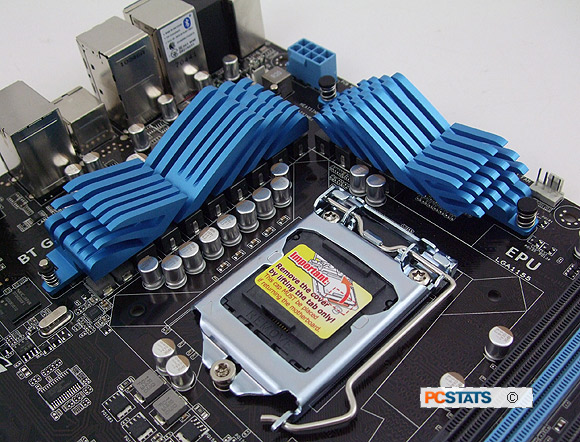
|
The ASUS P8P67 Pro motherboard is a pretty standard platform with a good feature set, ideal for mainstream overclockers and gamers.
75% Rating: 
|
|
|
|
Home >
Reviews >
Motherboards >
ASUS P8P67 Pro |
|
|
360-Degree Motherboard Gallery - Part 2
The ASUS P8P67 Pro motherboard is equipped
with four DDR-3 memory slots that accommodate up to
32GB of dual channel DDR3-1066/1333/1600/1866/2133/2200 memory. Extreme Memory Profile (XMP) RAM is supported
as you would expect.
At the top right corner we find the ASUS EPU switch and MemOK
button.
|

Clearance is average around the CPU
socket.
|
Like all Intel P67 platforms, the ASUS P8P67 Pro
accommodates 32nm Intel socket LGA1155 2nd Generation 'Sandy Bridge' Core
i3/i5/i7 2xxx-series processors and is not backwards compatible with socket
LGA1156 Lynnfield chips. The heatsink mounting holes are the same between
LGA1156 and LGA1155 heatsinks. Any aftermarket CPU cooler that supports one of
these CPUs will install on both. If in doubt, have a peek at Frostytech's
excellent Top 5 Heatsink chart.
Apparently, what you see under the VRM heatsinks is
ASUS' Digi+ VRM 12+2 phase power control with Dual Intelligent
processors.
ASUS MemOK is a feature that lights up when a
memory module is not properly installed. Pressing the button will command the
system to run through several failsafe memory settings at boot if you suspect a
memory stick is bad. The red light is part of the Q-Led system... basically a
red light indicating a device isn't correctly installed, or that item is
preventing the PC from booting.
ASUS' Energy Processing Unit (EPU) is built into
the motherboard with a physical IC. What the EPU does is dynamically alter the
amount of power phases the motherboard uses depending on usage and system load.
ASUS EPU is enabled with this switch here, allowing it to dynamical adjust power
draw and monitor usage.
Here we see the NEC USB 3.0 controller.
While USB 2.0's 480Mb/s maximum bandwidth was enough for
many years, USB 3.0 (above in blue) expands the bandwidth to a whopping 4.8Gb/s
(4800Mb/s) which is more appropriate for today's large mass storage devices.
Next up, a look at overclocking the ASUS P8P67 Pro motherboard!
|
